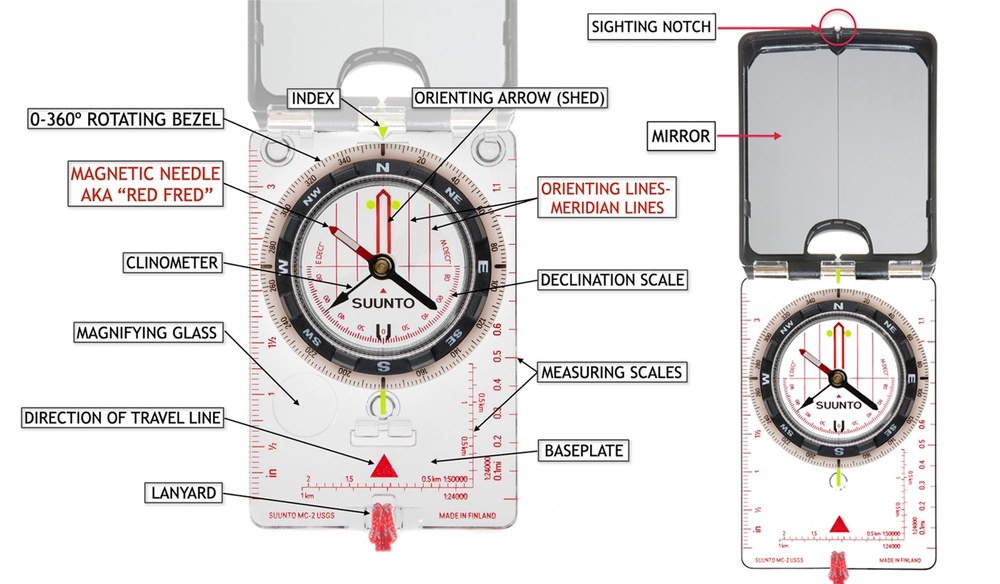
We get a lot of questions about compasses - and rightfully so! They're important. Follow these tips to select the compass that’s best for your needs. We suggest that you have this page handy for reference when you go the store to purchase a compass.
Updated February 9, 2022, to reflect our new compass requirements.
All compasses have a magnetized needle that points north, and have a way to indicate direction of travel. Mountaineering requires a compass with additional qualities. Compasses that hang from parka zippers or hook on watchbands are not suitable for most of our courses or as part of your Ten Essentials.
REQUIRED Compass FEATURES
Adjustable declination: This feature simplifies map and compass work. Most compasses with adjustable declination have an adjustment screw, usually brass or copper-colored, and a small key attached to the lanyard. Some have a ‘tool-less’, pinch-to-adjust feature.
- All students MUST have a compass with adjustable declination. The presence of a declination scale does not guarantee that it can be adjusted.
- Even if you already have a compass without adjustable declination, you may not use it in this course. Experience indicates that such compasses detract from the learning experience.
A transparent rectangular base plate with a direction of travel arrow or a sighting mirror.
- Transparency allows map features to be seen underneath the compass.
- A rectangular shape provides straight edges and square angles to plot on the map.
A 0 to 360 bezel (the rotating housing) marked clockwise from 0 to 360 degrees in increments of two degrees or less. Bezels should be large to allow use with gloves - the larger size also improves accuracy. Do not get one marked in 0-90 degree quadrants OR one marked in O-6400 mils!
Meridian lines: Parallel 'meridian lines' on the interior bottom of the circular compass housing rotate with the bezel when it is turned. Longer lines are better. Meridian lines run parallel to the north-south axis of the bezel, however turned, for use with a topo map.
A ruler and/or gradient scale engraved on one of the straight edges, used for measuring distances. In the U.S. 1:24000 scales (rather than 1:25000) are preferred. Both are acceptable.
A 3 to 4-inch base plate. A longer straight edge makes map work easier.
Additional recommendations
- A sighting mirror in the cover: May reduce error introduced when moving compass from eye-level after sighting to waist-level for reading the dial. Protects the bezel. May use as a signaling device.
- A liquid-filled housing: Reduces erratic needle movement (common on older compasses). In some cases, steadying the compass needle can be difficult. Don’t lanyard-swing a compass – a crash could start a leak.
- An inclinometer: A gravity driven arrow that allows you to measure slope angle.
Current favorites
Suunto and Silva are favorites. Brunton also has adjustable declination. Quality and usability vary, so keep any receipt. We have unfortunately seen defective compasses in the past.

Add a comment
Log in to add comments.As of 2016, the Mountaineers Navigation Course is called "Wilderness Navigation," and these compass requirements still apply.
For #5. SCALE -- Scales of 1:24,000 are preferred over 1:25,000
Additional Recommendations:
Brunton's current models (2015) use a tool-less declination that requires pressing down on the bezel. This can be difficult and cause the pieces to separate. Generally, however, the Brunton's meet our specifications.
Suunto's M3 and MC-2 continue to show a 2-5 degree magnetic error in many instances. Most can be corrected by adding another 2-5 degrees East declination (i.e.. 18 East instead of 16 East). The 2015 model has shorter meridian lines.
Beware of the "UST" compass available online via Amazon and other outlets. Our gear tests show it to be wholly unreliable. -- Brian Starlin, Navigation Committee Co-Chair
Seattle Navigation Committee update for "Compass Requirements for the Wilderness Navigation Course" dated September 2015 -- http://www.mountaineers.org/about/branches-committees/seattle-branch/committees/seattle-navigation-committee/files/required-compass-features-for-wilderness-navigation-2015-2016
As of mid-2016, Suunto has corrected the accuracy issues in their MC-2 compass, and it is once again recommended for Wilderness Navigation use.
For 2017 and 2018, the Seattle Navigation Committee has an updated Compass Requirements document at this URL...
https://www.mountaineers.org/about/branches-committees/seattle-branch/committees/seattle-navigation-committee/files/mountaineers-approved-compass/view
Brian Starlin, Seattle Navigation Chair
The document for "Mountaineers Approved Compass" has been updated as of June 2018. See it here:
https://www.mountaineers.org/about/branches-committees/seattle-branch/committees/seattle-navigation-committee/files/mountaineers-approved-compass/view
Brian Starlin, Seattle Navigation Chair
 The Mountaineers
The Mountaineers